
The Grinch. Chuck Jones, interviewed in Business Screen magazine (Aug/Sept 1982) said, “I think that’s why people like How The Grinch Stole Christmas, because here’s a guy who hates Christmas! Well, it doesn’t take much effort of our part to realize that we hate Christmas, too! But maybe we try to keep it to ourselves. But when someone comes along who hates Christmas completely and openly – we love it!
“Everybody hates Christmas a little bit. They won’t admit it, but they do. They’re worried about buying the right presents and so on. Here’s a guy who hated it completely and that was wonderful. I thought ‘I can embrace this’.”
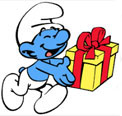 Sad Christmas Eve. The creator of The Smurfs, Pierre (Peyo) Culliford died of a heart attack at the age of 64 on Christmas Eve December 1992. Local radio stations in Belgium where Peyo lived announced his passing on Christmas Eve with “There is a village where Christmas will never be the same again. The Smurfs will be mourning their father tonight.”
Sad Christmas Eve. The creator of The Smurfs, Pierre (Peyo) Culliford died of a heart attack at the age of 64 on Christmas Eve December 1992. Local radio stations in Belgium where Peyo lived announced his passing on Christmas Eve with “There is a village where Christmas will never be the same again. The Smurfs will be mourning their father tonight.”
 Ziggy’s Gift. Ziggy’s Gift (1982) was an Emmy award winning ABC television Christmas special that first aired on December 1, 1982 about the comic strip character Ziggy becoming a street Santa for the holidays. The film was started by Richard Williams’ Los Angeles studio and directed by Williams. Before the project was finished, creator Tom Wilson pulled it from Williams, hired the animation staff himself and put twenty-seven year old Eric Goldberg in charge as Director of Animation to finish the production on time. Williams is still credited as the director. All the drawings were done directly on cels rather than being photocopied onto cels. Besides Goldberg, animation was supplied by Tom Sito, Kevin Petrilak, Tom Roth and Sue Kroyer.
Ziggy’s Gift. Ziggy’s Gift (1982) was an Emmy award winning ABC television Christmas special that first aired on December 1, 1982 about the comic strip character Ziggy becoming a street Santa for the holidays. The film was started by Richard Williams’ Los Angeles studio and directed by Williams. Before the project was finished, creator Tom Wilson pulled it from Williams, hired the animation staff himself and put twenty-seven year old Eric Goldberg in charge as Director of Animation to finish the production on time. Williams is still credited as the director. All the drawings were done directly on cels rather than being photocopied onto cels. Besides Goldberg, animation was supplied by Tom Sito, Kevin Petrilak, Tom Roth and Sue Kroyer.
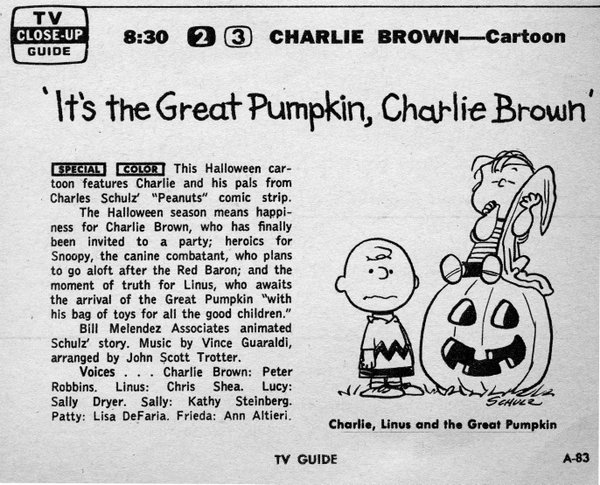
The Great Pumpkin. In TV Guide magazine for October 10-23, 2016, executive producer of It’s the Great Pumpkin, Charlie Brown Lee Mendelson recalled, “It’s certainly as popular as (A Charlie Brown Christmas) and I think Mr. Schulz liked it just as much. In some respects, it’s got strengths that the Christmas special doesn’t. It has the vibrant fall colors. It’s the first time Snoopy flew his doghouse. It was the first time for a lot of things in cartooning.
“It was that simple (that CBS wanted another Peanuts special since the first one was such a success). I got upset (that Charlie Brown was given a rock while trick-or-treating). When Charles suggested it, I said, ‘That’s kind of cruel’ but (animator) Bill Melendez was laughing with Schulz and said, ‘Let’s do it two or three times!’ It bothered (Schulz) that at Christmas so many kids didn’t get any gifts or maybe got one gift because their family didn’t have any money. He was trying to say, ‘Kids, you’ve going to survive even if you don’t get what you want’.”
Most of the child voice actors from the Yule outing returned as did composer Vince Guaraldi who Mendelson felt was “essential to bring the seasonal stories to life. His music really helped create the atmosphere.”

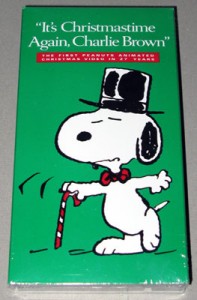 The Other Charlie Brown Christmas Special. It’s Christmas Time Again, Charlie Brown that aired in November 1992 was supposed to be a continuation of the classic A Charlie Brown Christmas from 1965. Shell Oil sold one and a half million copies of A Charlie Brown Christmas on VHS during the 1991 holidays and wanted a new one.
The Other Charlie Brown Christmas Special. It’s Christmas Time Again, Charlie Brown that aired in November 1992 was supposed to be a continuation of the classic A Charlie Brown Christmas from 1965. Shell Oil sold one and a half million copies of A Charlie Brown Christmas on VHS during the 1991 holidays and wanted a new one.
They agreed to share production costs with CBS. So It’s Christmas Time Again, Charlie Brown on VHS was available for sale for $4.99 with a fill-up at Shell gas stations beginning in September, roughly two months before the network airing. The show was not one cohesive story but really just a compilation of holiday sequences from a few Peanuts comic strips.
“Time has stood still,” creator Charles Schulz told USA Today in November. “When you look at this now, it’s almost as if it’s a continuation of the other one. The drawing is better. We had more time to work on it. But the tone of both shows is almost identical.”
While musician Vince Guaraldi had died in 1976, his music was played for the special by jazz pianist David Benoit. This was the last new Peanuts special to air on CBS and is considered the first straight-to-video Peanuts release. The posing was done by Larry Leichliter with Dean Spille designing the production.
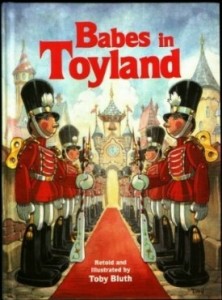 Toby Bluth’s Babes in Toyland. In December 1988, Toby Bluth’s updated version of the classic Victor Herbert musical Babes in Toyland opened as a California Music Theater production at the Pasadena Civic Auditorium. Robert Morse played the Toymaker and Peter Mark Richman was Mr. Barnaby.
Toby Bluth’s Babes in Toyland. In December 1988, Toby Bluth’s updated version of the classic Victor Herbert musical Babes in Toyland opened as a California Music Theater production at the Pasadena Civic Auditorium. Robert Morse played the Toymaker and Peter Mark Richman was Mr. Barnaby.
The Los Angeles Times newspaper found much trouble in Toyland’s new storyline. The production did win a Dramalog award for Toby Bluth, who was the brother of animator and director Don Bluth.
Dan Sullivan’s L.A. Times review from December 13, 1988 stated: “Bluth’s scenery suggests what (an animated) cartoon version would have looked like: the candy-cane village, the wise old half-moon, the forest glaring with animal eyes. It’s not original, but it’s a look. Bluth’s costumes also have style. It’s a more androgynous style than Disney would buy (Little Boy Blue–Chris Finch–wears hot pants), but it’s a distinct one.
“The finale brings all kinds of problems. Toyland is under laser attack — Barnaby and his entourage of G.I. Joe action-toys (who seem to have Contra connections) are on the march. How are they defeated? By unleashing an army of red-coated tin soldiers, who march through shot and shell jabbing their peppermint sticks at the audience like bayonets.”
 Japanese backers were interested in the show’s potential for merchandising so Bluth decided to rework the show. He had written and illustrated a short hardcover book about the story years before the show premiered.
Japanese backers were interested in the show’s potential for merchandising so Bluth decided to rework the show. He had written and illustrated a short hardcover book about the story years before the show premiered.
“I think film and television was always ready to jump on the merchandizing end of things but theater has never really caught on. Disney always used to take advantage of the merchandising of their characters. It’s just clever financing,” said Toby.
Most theater shows usually sell cast albums or souvenir programs but Toby had a line of fully-illustrated children’s books he had done, shirts and posters on sale when the show premiered.
Bluth later co-directed (with Charles Grosvernor and Paul Sabella) a direct-to-video animated feature of Babes in Toyland (1997) that was distributed by MGM/UA. Bluth served as production designer, and his book, Babes in Toyland, provided a style guide for the film.
“It is all based on and contains the images, the experiences and the love that was part of my childhood,” said Bluth when the film was released.
Originally, it was supposed to have been theatrically released but ended up being the first made-for-home-video movie from MGM Animation.
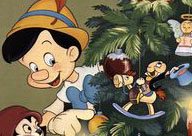 Pinocchio’s Christmas. The Disney Studio debated about including a winter scene or a full-fledged scene featuring Christmas in the animated feature Pinocchio (1940).
Pinocchio’s Christmas. The Disney Studio debated about including a winter scene or a full-fledged scene featuring Christmas in the animated feature Pinocchio (1940).
From a January 6, 1938 story meeting, Walt Disney said, “That’s the trouble – the exhibitors will class it as a Christmas picture and only run it at Christmas time. Well, Heidi had Christmas in it – they had quite a sequence there of Christmas…It doesn’t matter, we were just trying to get something pictorial in here.”
The Final Simpsons Christmas. In the October 10-23, 2016 issue of TV Guide magazine, The Simpsons showrunner Al Jean talked about what the very last episode of the series might be like. “To my mind, the best way to go out would be to have the final episode conclude with the Christmas pageant at Springfield Elementary School that began our first episode back in 1989. That way, it won’t really be an ending at all. It’ll turn the series into one continuous loop that will play on forever.”
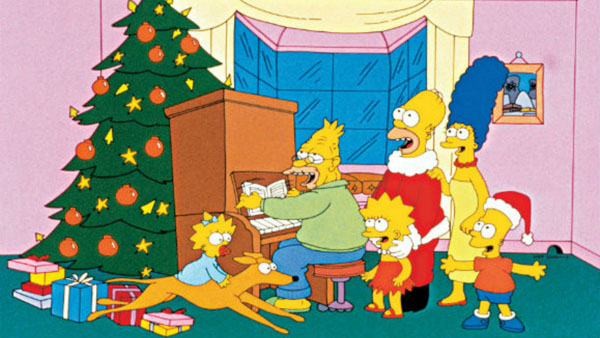


 Jim Korkis is an internationally respected animation historian who in recent years has devoted his attention to the many worlds of Disney. He was a columnist for a variety of animation magazines. With his former writing partner, John Cawley, he authored several animation related books including The Encyclopedia of Cartoon Superstars, How to Create Animation, Cartoon Confidential and Get Animated’s Animation Art Buyer’s Guide. He taught animation classes at the Disney Institute in Florida as well as instructing classes on acting and animation history for Disney Feature Animation: Florida.
Jim Korkis is an internationally respected animation historian who in recent years has devoted his attention to the many worlds of Disney. He was a columnist for a variety of animation magazines. With his former writing partner, John Cawley, he authored several animation related books including The Encyclopedia of Cartoon Superstars, How to Create Animation, Cartoon Confidential and Get Animated’s Animation Art Buyer’s Guide. He taught animation classes at the Disney Institute in Florida as well as instructing classes on acting and animation history for Disney Feature Animation: Florida.




















































It’s kind of neat that How The Grinch Stole Christmas was broadcast on all the “Big Three” networks and one cable network – first on CBS, and later Ted Turner took on the Grinch by broadcasting the special on TBS, TNT, Cartoon Network and Boomerang (much to public outcry, with many viewers who didn’t have cable calling Ted Turner a “Grinch” for taking the holiday special from “free tv”). After that, ABC picked up “HTGSC” but edited out several scenes to make room for more commercials, and then the now defunct WB Network. Now NBC is showing the restored “HTGSC” for its 50th anniversary of its broadcast premiere – while Cartoon Network shows the ABC edited version.
I’ve also seen the LATAM Spanish version of the “HTGSC” with two surprises: one, Whoville was renamed “Felizlandia” (Happyland) due to the fact that the Whos were happy. And two, a secretive message on when the Grinch realized that Christmas came to Whoville, even without the gift and the glitz which the narrator said about the coming of the Christ Child – and at the finale the narrator said the reason for Christmas was the birth of the Christ Child.
No doubt the LATAM version had to bring the message much closer to home for those viewers than what Seuss, Jones and Co. did back home.
Ziggy Gift is a brilliant cartoon. I never much cared for the strip itself, but appreciated it more after watching this wonderfully warm and touching christmas special. Sadly, somehow this gem has faded from the public view over the years. Perhaps some cable outlet will give it another airing in the coming year. Seems like anything Eric Goldberg has his hands in turns out to be something extra special. Love his Three Caballeros animation in Disney Worlds EPCOT CENTER.
Oh, I’d give far more credit to Richard Williams, whose devotion to quality animation really shines here. Who else could take a bland character like Ziggy, just a bunch of curved lines really, and stamp a warm and sympathetic personality on him? It’s done with a surprising amount of care, as I can’t imagine Williams was a big fan of Tom Wilson’s newspaper comic, but typically he goes beyond what’s required. There are also touches which remind you of Williams’ bollixed albatross, The Thief and the Cobbler, including a sneaky guy showing up in the margins and nabbing anything that isn’t nailed down.
It’s a shame that he couldn’t keep a deadline. I hope he is writing a memoir, because I’d like to hear his side of all this.
We hope, at least get it finished before his time on this planet is done.
“Babes in Toyland” has always been a troublesome piece. The original turn-of-the-century operetta was mainly a parade of song-and-dance acts, spectacular stage effects and comedy bits. Thereafter every adaptation started almost from scratch: Barnaby was usually maintained as a villain, the two pairs of romantic leads were reworked as one couple, and many songs were worked over with new lyrics (especially those devoted to 1903 satire).
Laurel and Hardy’s version, while using Herbert’s music as underscoring throughout, leaves just a few songs for the young lovers and concocts an original story with new characters for Stan and Ollie. The scenes in Boogeyland are a nod to a scene in the play where characters flee through a spooky forest and are menaced by a giant spider.
L&H’s climatic battle using toy soldiers has been picked up by later film adaptations, but there’s nothing like it in the original libretto. The operetta brings them onstage only for the famous march of the toys.
Bluth seems to have used it onstage, and animated feature deploys the toys against demonic creatures. So does an earlier television version starring Drew Barrymore. Disney’s version brings toy-sized toys to life to battle a full-sized Barnaby.
The Laurel & Hardy film also had the Disney Three Little Pigs in live action, played by a trio of little people wearing creepy rubber masks. And a couple of Our Gang shorts had elements from “Babes in Toyland”: the cave sets were reused in “Mama’s Little Pirate,” and Henry Kleinbach (after changing his name to Henry Brandon) reprised his Barnaby role in “Our Gang Follies of 1938,” though he was not named.
I recall seeing an interview Leonard Maltin had (probably for Entertainment Tonight) with Hal Roach’s FX guy, Roy Seawright, who talked about animating the scene with the 6-foot wooden soldiers. Seawright explained that their movements were deliberately jerky to emphasize their mechanical-ness.
And the L&H film was later re-titled “March of the Wooden Soldiers,” perhaps to avoid confusion with Disney’s later live-action film, I could be wrong here.
It was retitled “March…” as far back as the 1948 Lippert reissue, and possibly even earlier.
Rnigma: Wikipedia says the “March of the Wooden Soldiers” title came with a 1948 re-release by Lippert Pictures; and that the film was improbably retitled “Revenge is Sweet” for another re-release.
Back in the day, studios making a remake would try to buy up and lock away earlier versions of a property — or properties that bore a significant resemblance — to avoid competition and/or courtroom battles.
By the 60s “March of the Wooden Soldiers” was a television staple rather than a box office rival. I assume Disney didn’t have a legal basis to try and bottle it up — or any interest in doing so. There’s surprisingly little overlap.
Even so, Disney converts Barnaby’s operetta henchmen — missing from the L&H version — into imitation L&H (although Gene Sheldon adopts the dented hat and mannerisms of Harry Langdon, with touches of Harpo Marx). It’s as though Disney conceded they were, to audiences, part of the “real” Babes in Toyland.
Thanks for clearing that up. I do recall the Stan & Ollie-ish characters in the Disney version.
Not to disparage the accomplishments of Toby Bluth, but DramaLogue awards were given out like candy at Halloween. (Despite how many of them were awarded, I actually found it a fairer system than nominating five finalists who are narrowed down to one. All the DL critics gave out as many – or as few – awards as they felt merited commemorating.)